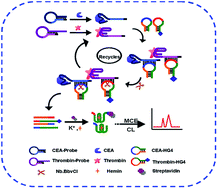当前位置:
X-MOL 学术
›
Anal. Methods
›
论文详情
Our official English website, www.x-mol.net, welcomes your feedback! (Note: you will need to create a separate account there.)
A novel dual target simultaneous chemiluminescence signal amplification strategy for enhancing sensitivity of multiple biomolecule detection†
Analytical Methods ( IF 3.1 ) Pub Date : 2017-11-15 00:00:00 , DOI: 10.1039/c7ay02102j Jian Li 1, 2, 3, 4 , Jingjin Zhao 1, 2, 3, 4 , Shuting Li 1, 2, 3, 4 , Liangliang Zhang 1, 2, 3, 4 , Chuanqing Lan 1, 2, 3, 4 , Yong Huang 1, 2, 3, 4 , Shulin Zhao 1, 2, 3, 4
Analytical Methods ( IF 3.1 ) Pub Date : 2017-11-15 00:00:00 , DOI: 10.1039/c7ay02102j Jian Li 1, 2, 3, 4 , Jingjin Zhao 1, 2, 3, 4 , Shuting Li 1, 2, 3, 4 , Liangliang Zhang 1, 2, 3, 4 , Chuanqing Lan 1, 2, 3, 4 , Yong Huang 1, 2, 3, 4 , Shulin Zhao 1, 2, 3, 4
Affiliation

|
Disease marker detection plays an important role in clinical practice; however, rapid, low-cost and simultaneous detection of multiple trace disease markers remain a challenge because of low abundance of related strategies. Herein, we report a G-quadruplex DNAzyme and nicking enzyme-assisted multiplex chemiluminescence (CL) signal amplification (EMCSA) strategy based on a microchip electrophoresis (MCE) platform for simultaneous detection of two trace target molecules. In this study, two target molecules coupled with their hairpin aptamer probes (H-probes), and the open H-probes hybridized with two different hairpin DNAs containing the G-quadruplex sequence (HG4) to form two different DNA duplexes. These DNA duplexes are then selectively cleaved by the nicking enzyme Nb.BbvCI, which forms the target–H-probe complexes and G-rich DNA segments. The obtained target–H-probe complexes hybridize again with another HG4 to form more DNA duplexes, which initiate continuous enzyme cleavage reaction to form more G-rich DNA segments. Free G-rich DNA segments combine with hemin and K+ to form G-quadruplex DNAzymes, which catalyze the CL reaction between hydrogen peroxide (H2O2) and luminol. Finally, G-quadruplex DNAzyme and streptavidin (SA)-functionalised G-quadruplex DNAzyme are quickly separated and detected by the MCE–CL platform. The proposed EMCSA-based MCE–CL method has been applied for simultaneous detection of two significant biomarkers, namely, thrombin (Tb) and carcinoembryonic antigen (CEA), in quantities as low as 2.4 pM and 0.11 ng mL−1 (0.62 pM), respectively. This method for simultaneous detection of two trace disease markers holds great potential in early clinical diagnosis of diseases.
中文翻译:

一种新颖的双目标同时化学发光信号放大策略,可增强多种生物分子检测的灵敏度†
疾病标志物检测在临床实践中起着重要作用。然而,由于相关策略的不足,快速,低成本和同时检测多种痕量疾病标志物仍然是一个挑战。在本文中,我们报告了基于微芯片电泳(MCE)平台的G四联体DNA酶和切刻酶辅助的多重化学发光(CL)信号放大(EMCSA)策略,用于同时检测两个痕量目标分子。在这项研究中,两个目标分子与它们的发夹适体探针(H-probes)偶联,并且开放的H-probes与包含G-四链体序列(HG4)的两个不同的发夹DNA杂交形成两个不同的DNA双链体。然后,这些双链体被切口酶Nb.BbvCI选择性切割,后者形成靶标-H探针复合物和富含G的DNA片段。获得的靶标H探针复合物再次与另一种HG4杂交形成更多的DNA双链体,从而引发连续的酶裂解反应以形成更多的富含G的DNA片段。富含G的自由DNA片段与血红素和K结合+形成G-四链体DNA酶,催化过氧化氢(H 2 O 2)和鲁米诺之间的CL反应。最后,通过MCE-CL平台可以快速分离并检测G-四链体DNAzyme和链霉亲和素(SA)功能化的G-四链体DNAzyme。提议的基于EMCSA的MCE-CL方法已被用于同时检测两种重要的生物标记,即凝血酶(Tb)和癌胚抗原(CEA),其数量低至2.4 pM和0.11 ng mL -1(0.62 pM) , 分别。同时检测两种痕量疾病标志物的这种方法在疾病的早期临床诊断中具有巨大的潜力。
更新日期:2017-11-15
中文翻译:

一种新颖的双目标同时化学发光信号放大策略,可增强多种生物分子检测的灵敏度†
疾病标志物检测在临床实践中起着重要作用。然而,由于相关策略的不足,快速,低成本和同时检测多种痕量疾病标志物仍然是一个挑战。在本文中,我们报告了基于微芯片电泳(MCE)平台的G四联体DNA酶和切刻酶辅助的多重化学发光(CL)信号放大(EMCSA)策略,用于同时检测两个痕量目标分子。在这项研究中,两个目标分子与它们的发夹适体探针(H-probes)偶联,并且开放的H-probes与包含G-四链体序列(HG4)的两个不同的发夹DNA杂交形成两个不同的DNA双链体。然后,这些双链体被切口酶Nb.BbvCI选择性切割,后者形成靶标-H探针复合物和富含G的DNA片段。获得的靶标H探针复合物再次与另一种HG4杂交形成更多的DNA双链体,从而引发连续的酶裂解反应以形成更多的富含G的DNA片段。富含G的自由DNA片段与血红素和K结合+形成G-四链体DNA酶,催化过氧化氢(H 2 O 2)和鲁米诺之间的CL反应。最后,通过MCE-CL平台可以快速分离并检测G-四链体DNAzyme和链霉亲和素(SA)功能化的G-四链体DNAzyme。提议的基于EMCSA的MCE-CL方法已被用于同时检测两种重要的生物标记,即凝血酶(Tb)和癌胚抗原(CEA),其数量低至2.4 pM和0.11 ng mL -1(0.62 pM) , 分别。同时检测两种痕量疾病标志物的这种方法在疾病的早期临床诊断中具有巨大的潜力。



























 京公网安备 11010802027423号
京公网安备 11010802027423号